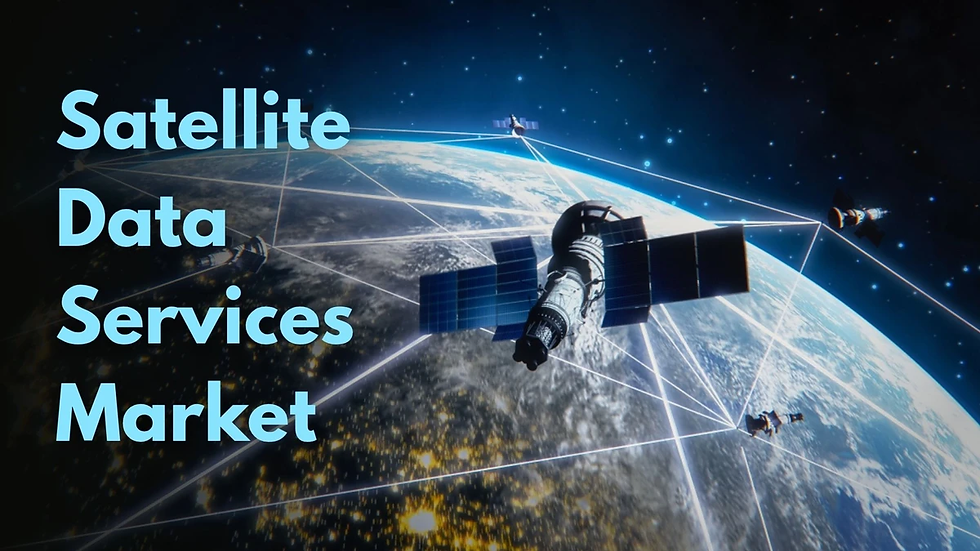Satellite Data Services Market Growth, Opportunities, and Forecast, 2024–2032
- Rishika Chavan
- Aug 6
- 3 min read
According to Fortune Business Insights™, the global satellite data services market size was valued at USD 4,876 million in 2023 and is expected to grow from USD 5,250 million in 2024 to USD 12,288 million by 2032, exhibiting a CAGR of 11.22% during the forecast period. This growth is attributed to the increasing demand for satellite-based data across diverse industries, driven by advancements in Earth observation, environmental monitoring, urban planning, and disaster management.
Understanding Satellite Data Services Satellite data, also referred to as satellite imagery, involves the collection of information about Earth and other celestial bodies through artificial satellites. The core application of satellite data is Earth Observation (EO), which allows users to monitor surface changes, weather patterns, and other environmental conditions. Satellite data can be captured via passive remote sensing, which relies on natural energy like sunlight, or active remote sensing, which uses radar waves to measure reflected signals.

Key Market Players
ICEYE (U.K.)
Planet Labs, Inc. (U.S.)
Capella Space (U.S.)
Airbus (Netherlands)
BlackSky (U.S.)
Maxar Technologies (U.S.)
Spire Global (U.S.)
EOS Data Analytics, Inc. (U.S.)
L3Harris Technologies, Inc. (U.S.)
Satellite Imaging Corporation (U.S.)
These companies are increasingly investing in technological advancements, including hyperspectral imaging, radar sensing, and high-resolution optical data services.
Information Source:
Market Segmentation Insights
By Type: The value-added services (VAS) segment held the largest share in 2023 due to growing demand for advanced analytics and actionable insights. Companies such as EOS Data Analytics and Planet Labs offer subscription-based services to deliver geospatial intelligence. VAS are extensively used in defense, agriculture, transportation, and energy industries.
By Industry: The defense & intelligence segment dominated the market, driven by the rising need for real-time surveillance, reconnaissance, and threat detection. Geopolitical tensions and conflicts, such as the Russia-Ukraine war, have emphasized the importance of timely, high-resolution satellite imagery in military decision-making.
By End Use: Military & government users accounted for the largest share of the market in 2023, supported by increased government initiatives to adopt satellite technologies for national security, public safety, and strategic planning.
Growth Drivers
Expansion of the Space Economy: The space economy is forecasted to reach USD 1.8 trillion by 2035. Growing investments from governments and private entities are accelerating the deployment of EO satellites, enhancing global access to satellite data.
Increased Industrial Applications: Satellite data supports decision-making across agriculture, disaster management, environmental monitoring, and urban development. In agriculture, EO helps in monitoring crop health and improving resource use efficiency.
Restraining Factors
High Initial Costs: Developing, launching, and maintaining satellite infrastructure involves considerable investment, often deterring small companies and startups from entering the market.
Key Trends
Technological Advancements: Companies like Maxar and Planet are expanding their offerings to include radar, RF, and hyperspectral imaging, enhancing the value and utility of satellite data.
High-Resolution Imaging Race: Firms like Albedo and EOI Space are developing imaging technologies capable of resolutions up to 10 cm. Established providers are moving toward resolutions of 15-25 cm, improving spatial accuracy for diverse applications.
Regional Insights
North America: With a market size of USD 1,716.8 million in 2023, North America leads due to its robust space infrastructure and support from agencies like NASA and the U.S. Department of Defense. The region continues to innovate through government-private partnerships and quality assessment frameworks, such as the ESA-NASA SAR Guidelines signed in June 2024.
Asia Pacific: Expected to witness the fastest growth during the forecast period, driven by rapid economic development, investments in space programs, and increasing demand from sectors such as agriculture, defense, and urban planning. Notably, China has overtaken the U.S. in several commercial remote sensing metrics, highlighting its rising competitiveness.
Competitive Landscape Market leaders are focusing on M&A, partnerships, and R&D to expand their service capabilities. They are developing hybrid satellite systems integrating SAR, optical, and RF sensors to offer richer data analytics and insights.
Recent Industry Developments
September 2024: ICEYE received a five-year contract from NASA to supply SAR data for the Commercial Smallsat Data Acquisition (CSDA) Program.
September 2024: BlackSky secured a contract from HEO to provide imagery of space objects, integrating SAR with non-Earth imaging sensors for real-time space situational awareness.



Comments